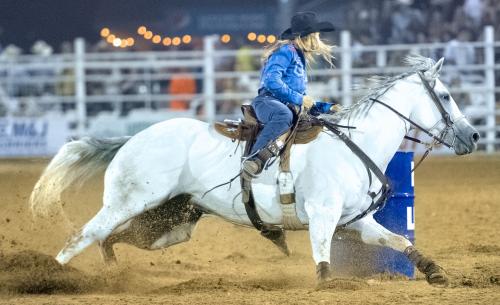Supplementing For Joint Health: What the Science Says

Owners are increasingly proactive about horse health, performance and longevity, which is clearly reflected in the ever-growing market for equine supplements, also known as nutraceuticals. In a 2017 survey of owners in the U.S., 84% reported giving supplements to at least one horse. Of these, 90% indicated they would use supplements to treat or prevent joint issues. Systemic therapies for joint disease are attractive because they are less invasive than intra-articular injections and thought to be conducive to long-term preventative support.
Despite the high use of supplements, there is little scientific evidence to back many products’ claims. Since nutraceuticals are not regulated by the U.S. Food and Drug Administration (FDA), safety and efficacy do not have to be proven. Some states require safety studies prior to marketing, but those rules can be difficult to enforce. Consequently, some independent laboratory analyses of active ingredients revealed that many products fall short of labeled amounts.
Ingredients found in equine oral joint supplements include:
Choosing an Oral Joint Supplement
Navigating equine oral joint supplements can be frustrating and challenging. Here are a few questions to help choose the right product(s) for your horse.
- Is the manufacturer an established, well-recognized company likely to produce high-quality, effective products?
- Has the product been evaluated in published, peer-reviewed clinical trials (i.e. independent studies performed by experts and reviewed by other experts)?
- Are all ingredients, including fillers, clearly indicated on the label?
- Are label claims realistic based on available study results, not just anecdotes and testimonials?
- Are instructions for dosing accurate and easy to follow?
- Is there a lot number or other identifier for tracking surveillance?
- Is customer service information easily accessible for questions or concerns?
Glucosamine and chondroitin sulfate – Glucosamine and chondroitin sulfate are precursors and components of glycosaminoglycans (GAGs), respectively. They are thought to slow cartilage degradation, stimulate new cartilage, and reduce inflammation. Although several studies have been performed, most have not shown improved joint heath. Questions have been raised about low bioavailability, or ability to be absorbed into the bloodstream from the gut and make their way to the joints. Substantial variation in product quality and concentration of glucosamine and chondroitin sulfate, as well as discrepancies in dosing recommendations, make it difficult to select appropriate supplements.
Avocado/soybean unsaponifiables (ASU) – Unsaponifiables are components of a fatty substance that are insoluble in water. A mixture extracted from avocado and soybean oils has suggested benefits for treating osteoarthritis (OA) in people. A study evaluating ASUs in a model of equine OA in the knee noted no significant side effects, modest improvements in cartilage and synovial membranes, but no differences in the degree of lameness. No adverse effects have been identified, but research is required to determine bioavailability and effective doses.
Resveratrol – Found in plants such as red grapes and blueberries, resveratrol is thought to have anti-oxidative and anti-inflammatory properties. A randomized clinical trial reported reduced hock lameness in horses with naturally occurring OA that were administered oral resveratrol (Equithrive) after IA triamcinolone hock injection compared with controls that received injection, followed by an oral placebo. This suggested that resveratrol may be a useful adjunct therapy in horses with OA and a good alternative to nonsteroidal anti-inflammatory drugs (NSAIDs). Another study showed no changes in measures of inflammation after three weeks of supplementation. A study of equine cartilage cells suggested that the compound may have chondroprotective effects, but noted dosing should be carefully controlled, as increased doses showed pro-inflammatory, and even cytotoxic, effects.

Methylsulfonylmethane (MSM) – An anti-inflammatory known to decrease joint pain and swelling in people with OA, MSM is a form of sulfur, an important component of GAGs. It is derived from dimethylsulfoxide (DMSO), commonly used in horses to combat inflammation. Found in fruit, alfalfa, and corn, MSM is often fed with glucosamine. Research on the efficacy of MSM for equine joint health is sparse, and available data is generally from combination products. One study reported that the use of a glucosamine/CS/MSM supplement had no effect on stiff gait in geriatric horses. Although no side effects have been observed, MSM should be used under veterinary supervision in horses with blood clotting disorders, hyperglycemia, shellfish allergies, or a history of urinary tract stones.
Herbs – Herbs such as Devil’s claw (Harpagophytum procumbens), garlic, Indian frankincense (Boswellia serrata), and yucca are increasingly popular for treating inflammation. However, most of these have not been scientifically tested in horses, and not much is known regarding safe, effective doses. It is important to note that some herbs can adversely interact with other dietary components or medications, so caution is required. Additionally, some herbal ingredients, such as Devil’s claw, are subject to competition regulations, so it is important to adhere to withdrawal times.
Fatty acids – Polyunsaturated fatty acids (PUFAs), found in fish and plants, are proposed to have anti-inflammatory and anti-oxidative effects. Potential roles for marine-derived omega-3 fatty acids eicosapentaenoic acid (EPA) and docosahexaenoic acid (DHA) have been investigated. However, data is minimal, and often conflicting, regarding the benefit of PUFA supplementation in horses with OA. After supplementation with EPA and DHA or flaxseed-derived fatty acids for 90 days, horses in one study did not show any changes in synovial fluid composition or pro-inflammatory compounds in the knee. Another study of supplementation for 75 days indicated horses exhibited longer stride lengths, but did not identify any changes in lameness.
